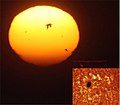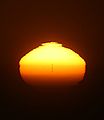Sunspot
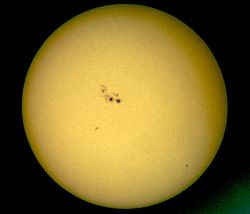
Sunspots are temporary features on the surface of the Sun (the photosphere) that appear visibly as dark spots compared to surrounding regions. They are caused by intense magnetic activity, which inhibits convection, forming areas of reduced surface temperature. Although they are at temperatures of roughly 5,000–6,500 K, the contrast with the surrounding material at about 5,800 K leaves them clearly visible as dark spots, as the intensity of a heated black body (closely approximated by the photosphere) is a function of T (temperature) to the fourth power. If a sunspot were isolated from the surrounding photosphere it would be brighter than an electric arc. Sunspots expand and contract as they move across the surface of the sun and can be as large as 80,000 km (50,000 miles) in diameter, making the larger ones visible from Earth without the aid of a telescope.
Sunspots, being the manifestation of intense magnetic activity, host secondary phenomena such as coronal loops and reconnection events. Most solar flares and coronal mass ejections originate in magnetically active regions around visible sunspot groupings. Similar phenomena indirectly observed on stars are commonly called starspots and both light and dark spots have been measured.[1]
Sunspot variation
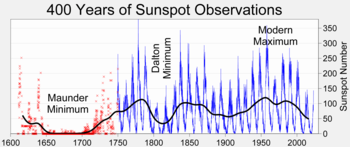
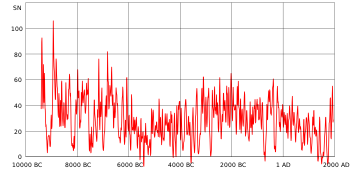
Sunspot populations quickly rise and more slowly fall on an irregular cycle about every 11 years. Significant variations of the 11-year period are known over longer spans of time. For example, from 1900 to the 1960s the solar maxima trend of sunspot count has been upward; from the 1960s to the present, it has diminished somewhat.[2] Over the last decades the Sun has had a markedly high average level of sunspot activity; it was last similarly active over 8,000 years ago.[3]
The number of sunspots correlates with the intensity of solar radiation over the period since 1979, when satellite measurements of absolute radiative flux became available. Since sunspots are darker than the surrounding photosphere it might be expected that more sunspots would lead to less solar radiation and a decreased solar constant. However, the surrounding margins of sunspots are brighter than the average, and so are hotter; overall, more sunspots increase the sun's solar constant or brightness. The variation caused by the sunspot cycle to solar output is relatively small, on the order of 0.1% of the solar constant (a peak-to-trough range of 1.3 W m−2 compared to 1366 W m−2 for the average solar constant).[4][5] Sunspots were rarely observed during the Maunder Minimum in the second part of the 17th century. This coincides with the middle (and coldest) part of a period of cooling known as the Little Ice Age.
There may be a resonant gravitational link between a photospheric tidal force exerted by the planets and the sunspot cycle.[6][7]
History

Apparent references to sunspots were made by Chinese astronomers in 28 BC (Hanshu, 27), who probably could see the largest groups of spots when the wind-borne dust filtered the sun's glare in Central Asian deserts. A large sunspot was also seen at the time of Charlemagne's death in A.D. 813. On 17 March 807 the Benedictine monk Adelmus observed a large sunspot, which was visible for eight days. Adelmus thought he was observing a transit of Mercury.[8] Sunspot activity in 1129 was described by John of Worcester. Averroes also provided a description of sunspots in the 12th century.[9] However, these early observations were misinterpreted until Galileo gave the correct explanation in 1612.
They were first observed telescopically in late 1610 by the English astronomer Thomas Harriot and Frisian astronomers Johannes and David Fabricius, who published a description in June 1611. At the latter time Galileo had been showing sunspots to astronomers in Rome, and Christoph Scheiner had probably been observing the spots for two or three months. The ensuing priority dispute between Galileo and Scheiner, neither of whom knew of the Fabricius' work, was thus as pointless as it was bitter.
Sunspots had some importance in the debate over the nature of the solar system. They showed that the Sun rotated, and their comings and goings showed that the Sun changed, contrary to Aristotle. The details of their apparent motion could not be readily explained except in the heliocentric system of Copernicus.
The cyclic variation of the number of sunspots was first observed by Heinrich Schwabe between 1826 and 1843 and led Rudolf Wolf to make systematic observations starting in 1848. The Wolf number is a measure of individual spots and spot groupings, which correlates to a number of solar observables. Also in 1848, Joseph Henry projected an image of the Sun onto a screen and determined that sunspots were cooler than the surrounding surface.[10]
Wolf also studied the historical record in an attempt to establish a database on past cyclic variations. His database extended only to 1700, although the technology and techniques for careful solar observations were first available in 1610. Gustav Spörer later suggested a 70-year period before 1716 in which sunspots were rarely observed as the reason for Wolf's inability to extend the cycles into the seventeenth century. The economist William Stanley Jevons suggested that there is a relationship between sunspots and business cycle crises. He reasoned that sunspots affect earth's weather, which, in turn, influences crops and, therefore, the economy.[11]
Edward Maunder later suggested that the Sun had changed from a period in which sunspots all but disappeared from the solar surface to a renewal of sunspot cycles starting in 1700. Careful studies revealed the problem not to be a lack of observational data but included references to negative observations. Adding to this understanding of the absence of solar cycles were observations of aurorae, which were absent at the same time. Even the lack of a solar corona during solar eclipses was noted prior to 1715.
Sunspots were rarely observed during the second part of 17th century in the time called the Maunder Minimum (1645–1717).
After the resumption of sunspot activity, Heinrich Schwabe in 1844 in "Astronomische Nachrichten"(Astronomical News) reported a periodic change in the number of sunspots. Since 1991, the Royal Observatory of Belgium acts as the World data center for the Sunspot Index.
Recent measurements, based also on observation of infra-red spectral lines, have suggested that sunspot activity may again be disappearing, possibly leading to a new minimum.[12]
Significant events
The sun emitted an extremely powerful flare toward Earth on 1 September 1859. It interrupted electrical telegraph service and caused visible Aurora Borealis as far south as Havana, Hawaii, and Rome with similar activity in the southern hemisphere.
The most powerful flare observed by satellite instrumentation began on 4 November 2003 at 19:29 UTC, and saturated instruments for 11 minutes. Region 486 has been estimated to have produced an X-ray flux of X28. Holographic and visual observations indicate significant activity continued on the far side of the Sun.
Physics

Although the details of sunspot generation are still a matter of research, it appears that sunspots are the visible counterparts of magnetic flux tubes in the sun's convective zone that get "wound up" by differential rotation. If the stress on the tubes reaches a certain limit, they curl up like a rubber band and puncture the sun's surface. Convection is inhibited at the puncture points; the energy flux from the sun's interior decreases; and with it surface temperature.
The Wilson effect tells us that sunspots are actually depressions on the sun's surface. Observations using the Zeeman effect show that prototypical sunspots come in pairs with opposite magnetic polarity. From cycle to cycle, the polarities of leading and trailing (with respect to the solar rotation) sunspots change from north/south to south/north and back. Sunspots usually appear in groups.
The sunspot itself can be divided into two parts:
- The central umbra, which is the darkest part, where the magnetic field is approximately vertical (normal to the sun's surface).
- The surrounding penumbra, which is lighter, where the magnetic field lines are more inclined.
Magnetic field lines would ordinarily repel each other, causing sunspots to disperse rapidly, but sunspot lifetime is about two weeks. Recent observations from the Solar and Heliospheric Observatory (SOHO) using sound waves traveling through the Sun's photosphere to develop a detailed image of the internal structure below sunspots show that there is a powerful downdraft underneath each sunspot, forming a rotating vortex that concentrates magnetic field lines. Sunspots are self-perpetuating storms, similar in some ways to terrestrial hurricanes.

Sunspot activity cycles about every eleven years. The point of highest sunspot activity during this cycle is known as Solar Maximum, and the point of lowest activity is Solar Minimum. Early in the cycle, sunspots appear in the higher latitudes and then move towards the equator as the cycle approaches maximum: this is called Spörer's law.
Wolf number sunspot index displays various periods, the most prominent of which is at about 11 years in the mean. This period is also observed in most other expressions of solar activity and is deeply linked to a variation in the solar magnetic field that changes polarity with this period, too.
The modern understanding of sunspots starts with George Ellery Hale, which links magnetic fields and sunspots. Hale suggested that the sunspot cycle period is 22 years, covering two polar reversals of the solar magnetic dipole field. Horace W. Babcock later proposed a qualitative model for the dynamics of the solar outer layers. The Babcock Model explains that magnetic fields cause the behavior described by Spörer's law, as well as other effects, which are twisted by the Sun's rotation.
Sunspot observation

Sunspots are observed with land-based and Earth-orbiting solar telescopes. These telescopes use filtration and projection techniques for direct observation, in additional to various types of filtered cameras. Specialized tools such as spectroscopes and spectrohelioscopes are used to examine sunspots and sunspot areas. Artificial eclipses allow viewing of the circumference of the sun as sunspots rotate through the horizon.
Since looking directly at the Sun with the naked eye permanently damages vision, amateur observation of sunspots is generally conducted indirectly using projected images, or directly through protective filters. Small sections of very dark filter glass, such as a #14 welder's glass are effective. A telescope eyepiece can project the image, without filtration, onto a white screen where it can be viewed indirectly, and even traced, to follow sunspot evolution. Special purpose hydrogen-alpha narrow bandpass filters as well as aluminum coated glass attenuation filters (which have the appearance of mirrors due to their extremely high optical density) on the front of a telescope provide safe observation through the eyepiece.
Amateur observers should not use filters, no matter how dark, unless they are specifically intended for solar viewing. Other filters may not provide appropriate protection in the non-visible frequency range and eye damage could result. When using a telescope or binoculars for direct viewing with a filter, follow the manufacturers' guidelines closely. These will usually require the filter to be placed at the objective (far) end of the instrument, since the instrument concentrates heat as well as light and may damage an eyepiece filter and cause immediate eye damage. Securely fasten the filter and ensure that attached auxiliary devices such as spotter scopes have hoods in case they concentrate heat dangerously. Direct observation of the sun's surface through an optical device is inherently dangerous, and requires both knowledge and close attention to safety precautions.
Application
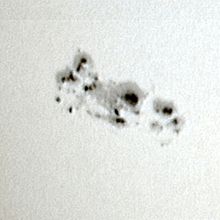
Due to their link to other kinds of solar activity, sunspots can predict space weather and the state of the ionosphere. Thus, sunspots can help predict conditions of short-wave radio propagation or satellite communications.
Don Easterbrook, a Professor Emeritus of geology at Western Washington University, claims that there is a cause-and-effect relationship between sunspot activity and measured changes in global temperatures on Earth.
Starspots on other stars
In 1947 G. E. Kron proposed that spots were the reason for periodic changes in brightness on red dwarfs.[1] Since the mid-1990s starspot observations have been made using increasingly powerful techniques yielding more and more detail: photometry showed starspot growth and decay and showed cyclic behavior similar to the Sun's; spectroscopy examined the structure of starspot regions by analyzing variations in spectral line splitting due to the Zeeman Effect; Doppler imaging showed differential rotation of spots for several stars and distributions different from the Sun's; spectral line analysis measured the temperature range of spots and the stellar surfaces. For example, in 1999, Strassmeier reported the largest cool starspot ever seen rotating the giant K0 star XX Triangulum (HD 12545) with a temperature of 3,500 kelvins, together with a warm spot of 4,800 kelvins.[1][13]
Gallery
-
Sunspot 923 at sunset and in solar scope
-
Sunset Superior Mirage of sunspot #930
-
Sunset in Bangladesh, January 2004
See also
References
- ^ a b c press release 990610, K. G. Strassmeier, 1999-06-10, University of Vienna, "starspots vary on the same (short) time scales as Sunspots do", "HD 12545 had a warm spot (350 K above photospheric temperature; the white area in the picture)"
- ^ Sunspot index graphics, Solar Influences Data Analysis Center (retrieved 27 September 2007).
- ^
Solanki, S.K. (2004). "Unusual activity of the Sun during recent decades compared to the previous 11,000 years". Nature. 431: 1084–1087. doi:10.1038/nature02995.
{{cite journal}}: Unknown parameter|coauthors=ignored (|author=suggested) (help) - ^ "Solar Forcing of Climate". Climate Change 2001: Working Group I: The Scientific Basis. Retrieved 2005-03-10.
- ^ Weart, Spencer (2006). Weart, Spencer (ed.). "The Discovery of Global Warming". American Institute of Physics. Retrieved 2007-04-14.
{{cite web}}:|contribution=ignored (help) - ^ Wainwright, G. (2004). "Jupiter's influence". New Scientist. Retrieved 27 September 2007.
- ^
Wilson, Ian. "Do periodic peaks in the planetary tidal forces acting upon the Sun influence the sunspot cycle?". Retrieved October 07 2009.
{{cite journal}}: Check date values in:|accessdate=(help); Cite journal requires|journal=(help) - ^
Wilson, E. R. "A Few Pre-Copernican Astronomers". Popular Astronomy. p. 93.
{{cite web}}: Unknown parameter|Volume=ignored (|volume=suggested) (help) - ^ Ead, Hamed A. "Averroes As A Physician". University of Cairo.
- ^
Hellemans, Alexander (1988). The Timetables of Science. New York, New York: Simon and Schuster. p. 317. ISBN 0671621300.
{{cite book}}: Unknown parameter|coauthors=ignored (|author=suggested) (help) - ^
Carlos Garcia-Mata C, Shaffner FI (1934=11). "Solar and economic relationships: a preliminary report". The Quarterly Journal of Economics. 49 (1). The MIT Press: 1-51.
{{cite journal}}: Check date values in:|date=(help) - ^ [1]
- ^ derived images showing rotation of cool and warm starspots
External links
- Solar Cycle 24 and VHF Aurora Website (www.solarcycle24.com)
- Belgium World Data Center for the sunspot index
- High resolution sunspot image
- Sunspot images in high-res Impressive collection of sunspot images
- http://www.tvweather.com/awpage/history_of_the_atmosphere.htm
- NOAA Solar Cycle Progression: Current solar cycle.
- Current conditions: Space weather
- Lockheed Martin Solar and Astrophysics Lab
- Sun|trek website An educational resource for teachers and students about the Sun and its effect on the Earth
- Tools to display the current sunspot number in a browser
- The Sharpest View of the Sun
- Daily Sunspot Update and Picture of the Sun (www.spaceweather.com)
- Animated explanation of Sunspots in the Photosphere (University of Glamorgan)
Sunspot data
- "11,000 Year Sunspot Number Reconstruction". Global Change Master Directory. Retrieved 11 March 2005.
{{cite web}}: Unknown parameter|dateformat=ignored (help)- "Unusual activity of the Sun during recent decades compared to the previous 11,000 years". WDC for Paleoclimatology. Retrieved 11 March 2005.
{{cite web}}: Unknown parameter|dateformat=ignored (help)
- "Unusual activity of the Sun during recent decades compared to the previous 11,000 years". WDC for Paleoclimatology. Retrieved 11 March 2005.
- "Sunspot Numbers from Ancient Times to Present from NOAA/NGDC". Global Change Master Directory. Retrieved 11 March 2005.
{{cite web}}: Unknown parameter|dateformat=ignored (help)- "SUNSPOT NUMBERS". NOAA NGDC Solar Data Services. Retrieved 11 March 2005.
{{cite web}}: Unknown parameter|dateformat=ignored (help)- International Sunspot Number—sunspot maximum and minimum 1610-present; annual numbers 1700-present; monthly numbers 1749-present; daily values 1818-present; and sunspot numbers by north and south hemisphere. The McNish-Lincoln sunspot prediction is also included.
- American sunspot numbers 1944-present
- Ancient sunspot data 165 BC to 1684 AD
- Group Sunspot Numbers (Doug Hoyt re-evaluation) 1610-1995
- "SUNSPOT NUMBERS". NOAA NGDC Solar Data Services. Retrieved 11 March 2005.

